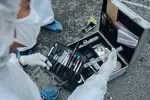Forensic Animation
Forensic animation refers to the use of audio-visual simulations within a legal context. Most commonly in the form of computer generated 3D graphics, applications of forensic animation include virtual recreations of accidents and crime scenes.
Want To Study Forensics/CSI?
Forensic Animation in the Courtroom
An animation is merely a sequence of illustrations that, when filmed, videotaped, or computer generated, creates the illusion that the illustrated objects are in motion. With an animation, there is no intent to recreate or simulate an event. The animation merely demonstratively depicts witness testimony. Although one cannot cross examine the animation itself, one can still cross-examine the witness upon whose testimony the animation was created. Thus, it is required that a witness (1) has personal knowledge of the scene depicted in the animation; and (2) witnessed the event depicted in the animation as it actually transpired. The reliability of the animation depends completely on the witness’s testimony and credibility. The witness can be fully cross-examined regarding the animation which, again, is simply the graphic depiction of the witness’s testimony.
|
This type of computer-generated evidence generally does not present special admissibility problems. Demonstrative evidence is not normally used during jury deliberations, and courts should apply a less rigorous standard in allowing their use in the courtroom. |
|
Some courts have, however, distinguished between animations used to illustrate lay versus expert testimony. The distinctions, however, have only been made because courts have not used uniform terminology when dealing with computer generated evidence.
Re-Creations
Re-creations are just animations in the technical sense – images generated by a computer that produce the image of motion – but the source of the input data is different and more involved. Instead of eye-witness testimony, as with animations, re-creations are created by inputting scientific data into a computer program. Thus, re-creations are derived from a series of images generated on a computer (like an animation), but they rely upon data collected. The input data is not merely a witness’s description of an event that has been witnessed and is now described better through animation (although it certainly could be used that way as a demonstrative exhibit). Instead, the input data must be independently determined and confirmed and then "fed into" the computer. The computer program must then process that input data to generate an image or a result of what “must have happened” given the input data and the scientific assumptions underlying the computer program.
The general image must rely on the validity of that input data, the assumptions made by the computer program, the reliability of the computer programmer to correctly input the information, and the computer program to correctly process that information so that the end result can be characterized as a "re-creation" of what must have happened according to the computer program and the input data. The reliability of a re-creation stems not from eyewitness accounts of past events, but from the input data itself (skid marks, or other measurements and scientific readings), along with the reliability of the computer programmer, the assumptions made by the computer program to generate the correct result, and how it depicts via computer imagery what must have actually happened. Both animations and re-creations are backward-looking in that they always depict an event that has occurred in the past.
Simulations
Simulations are predictive. In essence, a computer simulation creates new evidence from pre-existing data. This is called a computer model or "simulation" because an expert enters a compilation of mathematical formulae or other scientific principles into the computer so that the computer can generate a model – based on the data and scientific assumptions – that the expert will use to form an opinion as to what must have or could have actually happened. The key difference between a simulation and a re-creation or animation is that the former is used by an expert to arrive at his opinion, while the latter is used to illustrate his opinion so that it can be visualized by the jury. An expert bases his opinion testimony on a simulation, as opposed to merely illustrating his opinion to a jury with a re-creation or forensic animation.
Information via: Inga Hofer, 'The Rise of Courtroom Technology and its Effect on the Federal Rules of Evidence and the Federal Rules of Civil Procedure.'
Recent Articles
-
All About Forensic Science
Nov 12, 24 03:05 AM
A forensic science website designed to help anybody looking for detailed information and resources. -
The Role of Forensic Evidence in Criminal Defense Cases
Sep 05, 24 03:38 AM
Article exploring five key roles that forensic evidence plays in criminal defense cases -
The Evolving Role of Medical Science in Forensic Investigations
Aug 06, 24 03:35 AM
Insightful article exploring the critical role of medical science in forensic investigations.


New! Comments
Have your say about what you just read! Leave me a comment in the box below.